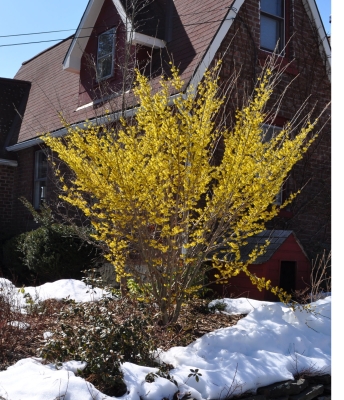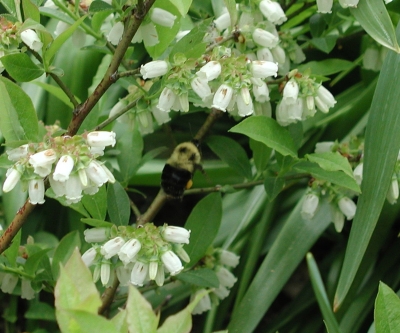BEE GLORY, GONE (FOR NOW)
Arnold’s Promise?
I miss the bees. No, they’re not gone from here because of Colony Collapse Disorder (CCD), widely responsible for the loss of bees. Most years, they would have been here and perhaps gone on to greener pastures by now.

The bees come for my witchhazel, and the reason for their absence this year is because my witchhazel didn’t bloom. It usually blooms in late winter or very early spring. And it won’t bloom this season at all. The reason is because it bloomed last fall.
It’s not uncommon for an early spring bloomer such as witchhazel to jump the gun and bloom in fall. And the cause for this behavior is growing conditions through summer that send the plant into a kind of sleep, then fall conditions that all of a sudden shake the plant awake. My guess is that the plant considered the very dry weather last summer an ersatz winter, and cooler and moister conditions in fall were an ersatz spring.

Witchhazel, spent blooms from past autumn
I’d prefer, and the bees also might prefer, for the plant — Arnold’s Promise variety of witchhazel — to bloom on its usual, this side, of the calendar. We’re all much hungrier now for all that visual and aromatic glory. The bees seem happiest with the spring blooms, making the bush all a-buzz with their frenzied flitting moving from flower to flower. These early blossoms provide the nectar and the pollen they need to get going in spring.

Witchhazel in full bloom in past years
What’s So Good About Honeybees?
Honeybees are much more valuable for their pollination services than for the honey and beeswax we sneak from them. Many crops – almost all those with showy flowers – need the pollination services of bees in order to set seeds or make fruits.
I once kept bees, so can attest to the fact that they make very interesting pets. Their social organization rivals that of any other creature. (Humans are not even in this running.) Each bee knows and does his or her job. The hive’s sole queen leaves the hive but once in her life to get fertilized by males, after which the latter, their genitals ripped from their bodies, die. Guard bees protect the entrance from interlopers.
On calm, balmy days, workers spend their days seeking out and gathering nectar and pollen from flowers. A worker, upon finding a good source of nectar and pollen, returns to the hive and does a dance that communicates to other workers the location of that bounty. This bee “language” is so evolved that different varieties of bees have different “dialects.”
For a fascinating description of the experiments that led to the discovery of those “bee dances,” take a look at the book The Dancing Bees by Karl Von Frisch, who, in 1973, received the Nobel Prize for his work with bees.
Luckily, There are Other Bees
Looking at those ecstatic bees on my witch hazel bush years ago, it struck me that perhaps what I was looking at were not, in fact, honeybees. My personal observations here on the farmden notwithstanding, honeybees are, in fact, on the decline. But they’re not the only bees on the block. Honeybees weren’t even “on the block” a few hundred years ago because they’re not native to North America.
North America has plenty of wild bees, though, almost 4000 species of them! Our wild bees – including, for example, carpenter bees, bumblebees, orchard mason bees, and hornfaced bees — are very efficient pollinators, going outside to work during weather in which honeybees remain huddled in their hives. These native bees get up earlier in spring and earlier each day, and don’t need the calm weather (wind less than 15 mph) and warm temperatures (greater than 55 degrees F) demanded by honeybees. Native bees also are more gentle than honeybees, rarely stinging. They don’t, however, make honey or beeswax.

Bumblebee on blueberry plant
Unfortunately, native bee populations are also on the decline these days, due mostly to habitat destruction and pesticide poisoning. Some people build special nestboxes for these helpful insects, which require nothing more than tubes in which to lay eggs, anything from bundles of straws to wooden blocks into which holes have been drilled.
Whatever I’m doing that has kept those bees on my witchhazel happy will have similar effect whether the bees are honeybees or native bees. Because some native bees nest in the ground, our gardening practices can influence their well-being. The website of the Xerces Society details the effects of a number of gardening practices on native bees. Tillage, for example, can be detrimental, as are the pesticides copper sulfate, sulfur, and rotenone. Maintaining wild habitats is also important to their survival.
I’m hoping next winter or spring to see my Arnold’s Promise awash in fragrant, yellow blossoms and all abuzz with bees, whether honeybees or native bees.



I noticed the witch hazel, and other wild plants in our woods blooming last autumn too.
I really enjoyed this post. Thanks.
Happy March!
Carin
Thanks, as always, for an interesting and visually-satisfying post.
I have noticed witchhazel blossoms up here in Mount Tremper most often in January. I was bowled over the first time i turned my head in a snowfall and their yellow blossoms popped out under the soft white flakes.
Enjoy this gorgeous song about them –
https://www.youtube.com/watch?v=BE9SIQklni4
There are a few species and many varieties of witchhazel. Depending on both and a plant’s regular bloom bloom time might be fall, winter, or early spring.
My hellebores always seem to bee the big attractant in early spring.
One of my primrose bloomed last October. I thought it might be done for the year but it has come back very strong.